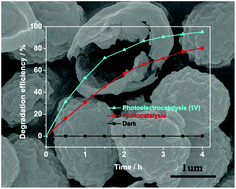Synthesis and photoelectrocatalytic activity of In2O3 hollow microspheres via a bio-template route using yeast templates
Abstract
Indium oxide (In2O3) hollow microspheres were prepared using yeast as a bio-template with the aid of a precipitation method. The yeast provided a solid frame for the deposition of In(OH)3 to form the precursor. The resulting In2O3 hollow microspheres were obtained by calcining the precursor at 650 °C. The samples were characterized by X-ray diffraction (XRD), X-ray photoelectron spectroscopy (XPS), Fourier transform infrared spectroscopy (FT-IR), scanning electron microscopy (SEM), transmission electron microscopy (TEM), N2 adsorption–desorption isotherms and UV–Vis diffuse reflectance spectroscopy. The results showed that the diameter of the In2O3 hollow microspheres was about 2.0–3.0 μm and the spherical shells were composed of In2O3 nanoparticles with a size of ∼20 nm. The BET specific surface area of the sample was 19.23 m2 g−1. The photoelectrocatalytic test results showed that the photoelectrocatalytic degradation efficiency of methylene blue (MB) using In2O3 hollow microspheres as catalysts under visible light irradiation and a certain voltage could reach above 95% after 4 hours, much higher than that of only photodegradation. The enhanced photoelectrocatalytic activity could be attributed to the hydroxyl radicals HO˙ produced by the light irradiation reaction process which could oxidize the electron donors and were beneficial to reducing the recombination of electrons and holes.



 Please wait while we load your content...
Please wait while we load your content...